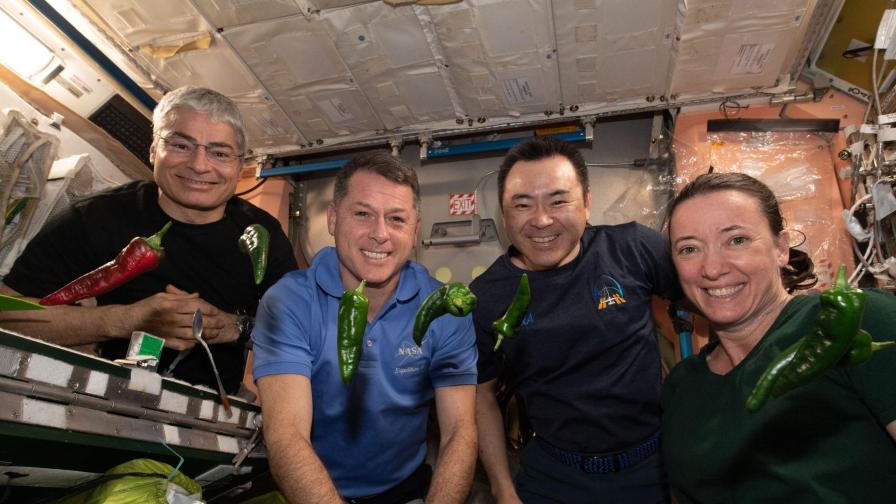Growing and Eating Chile Peppers in Space! NASA Experiment a Spicy Success

Astronauts (from left) Mark Vande Hei, Shane Kimbrough, Akihiko Hoshide, and Megan McArthur pose with chile peppers grown in space for the first time aboard the International Space Station for the Plant Habitat-04 investigation.
Photo courtesy of NASA
Trying to grow food crops in space is one thing. Successfully harvesting and consuming fruits of the lofty labor is another. Astronauts aboard the International Space Station recently added some spice to their diets when they got to sample seven freshly harvested mild chile peppers. The peppers had been growing since July 12 when astronaut Shane Kimbrough initiated the experiment in the Advanced Plant Habitat (APH). This is the first time astronauts have eaten peppers grown in space.
The experiment known as Plant Habitat-04 is growing a hybrid variety called the ‘Española Improved NuMex‘ pepper, which researchers selected because peppers are an excellent source of vitamin C and they performed best in ground tests in the APH. This is the first of two harvests for the experiment. A second is planned for the end of this month.
According to NASA, compared to the 10 previous space crops astronauts have grown and eaten aboard the station, growing chile peppers has been one of the most challenging experiments. Peppers have longer growing times and, unlike radishes or leafy greens, require pollination before fruit develop. To overcome those challenges, plant researchers on the ground used APH’s more than 180 sensors and controls to closely monitor the peppers and precisely control the environment for optimal growing conditions. Those researchers also had help from astronauts willing to lend a hand (check out the video clip below).
I loved getting my hands on the pepper plants and pollinating them! I felt a much higher-than-usual level of focus compared to tending plants on Earth. Of course I played Red Hot Chili Peppers for them! 🌶 See why we are growing this complicated crop: https://t.co/7YJ8yfrRfP pic.twitter.com/8MnpLVbYoA
— Megan McArthur (@Astro_Megan) September 14, 2021
This experiment is part of NASA’s research into growing crops in space since fruits and vegetables can supplement astronauts’ diet with key nutrients like vitamin C and vitamin K, which explorers will need during long-duration deep space missions in the future.










